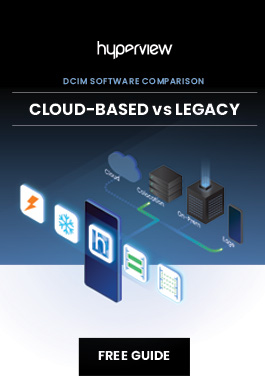Hyperview’s SaaS Model: A New Era for Data Center Infrastructure Management
In the early days of transportation, steam locomotives were the pinnacle of innovation. They enabled people to travel faster than ever before and connected remote areas. However, they were large, heavy, and required substantial resources to operate and maintain.
Similarly, on-premises enterprise software was once revolutionary, enabling businesses to automate processes and manage operations with unprecedented ease. Yet, it often comes with heavy infrastructure requirements, high upfront costs, and a need for dedicated IT staff for maintenance and updates.
On the other hand, the bullet train represents the future of high-speed transportation. It is sleek, efficient, and can quickly adapt to changing conditions. This modern marvel requires significantly less maintenance and offers a more comfortable, convenient experience for passengers. In the same vein, software-as-a-service (SaaS) provides businesses with a streamlined, flexible, and easily scalable software solution. With cloud-based infrastructure, businesses can quickly implement and access the software without the need for large upfront investments or dedicated IT staff. Updates and new features are automatically deployed, ensuring that the software remains at the cutting edge of technology.
SaaS is akin to trading in a lumbering steam locomotive for a sleek, efficient bullet train – a journey toward a more agile, cost-effective, and innovative way of doing business.
It comes then as no surprise that the rise of cloud computing and SaaS has dramatically transformed the way businesses manage their IT infrastructure. Among the numerous software providers like Salesforce and Adobe that have adopted SaaS is Hyperview, a leading Data Center Infrastructure Management (DCIM) provider. By choosing to be a cloud-based DCIM rather than an on-premises enterprise software, Hyperview has successfully carved a niche for itself in the rapidly evolving data center management landscape. Let us explore the reasons behind Hyperview’s strategic decision and the benefits it brings to their users.
Cost Efficiency and Scalability
One of the primary reasons Hyperview chose to adopt the SaaS model is the cost efficiency and scalability it offers. On-premises enterprise software often requires significant upfront investments in hardware, software licenses, and personnel to manage the system. In contrast, SaaS DCIM solutions like Hyperview’s provide a subscription-based pricing model, which allows users to pay only for the services they need.
This approach not only reduces initial costs but also ensures that businesses can scale their DCIM requirements up (or down) as needed, without the need for expensive hardware upgrades or the procurement of additional licenses.
Faster Implementation and Easier Upgrades
The SaaS model enables Hyperview to offer faster implementation and easier upgrades compared to on-premises solutions. Deploying an on-premises DCIM system is a complex and time-consuming process, often taking many months to complete. With SaaS, customers can access Hyperview’s platform almost instantly upon subscription, significantly reducing the time to value.
Moreover, as Hyperview handles all software updates and maintenance, users benefit from a seamless and hassle-free experience. This ensures that they always have access to the latest features and security updates without having to worry about the logistics of upgrading their on-premises systems.
Enhanced Security and Compliance
Data security and compliance are top concerns for businesses, and Hyperview’s SaaS model addresses these concerns effectively. By hosting their platform in secure data centers and partnering with reputable cloud providers like Microsoft Azure, Hyperview can offer enterprise-grade security measures, including encryption, access control, and regular security audits.
This approach allows Hyperview to stay up to date with the latest security and compliance standards, ensuring that their customers’ data is always protected and compliant with industry regulations.
Flexibility and Accessibility
Hyperview’s DCIM SaaS model offers increased flexibility and accessibility, enabling businesses to manage their data centers from anywhere with an internet connection. This is particularly useful for organizations with multiple data centers or those who need to provide access to multiple users across different locations.
By offering a centralized and easily accessible platform, Hyperview ensures that users can effectively monitor and manage their infrastructure, no matter where they are located.
Conclusion
Just like choosing a bullet train over a steam locomotive for high-speed transportation, Hyperview’s decision to be a SaaS DCIM provider has been a strategic one. By offering cost efficiency, scalability, faster implementation, easier upgrades, enhanced security, compliance, flexibility, and accessibility, Hyperview has successfully addressed the growing demands of modern data center environments. As more businesses recognize the benefits of SaaS solutions for their infrastructure management needs, Hyperview’s choice to embrace this model will continue to be at the center of its growth story.
Experience first-hand how fast, easy and affordable SaaS DCIM is. Schedule a free one-on-one demo of Hyperview today.
If you would like to learn more about the difference between SaaS and on-premises DCIM softwares, download this free guide.

The post Hyperview’s SaaS Model: A New Era for Data Center Infrastructure Management appeared first on Hyperview.
*** This is a Security Bloggers Network syndicated blog from Hyperview authored by Rajan Sodhi. Read the original post at: https://www.hyperviewhq.com/blog/hyperview-saas-a-new-era-for-data-center-infrastructure-management/





